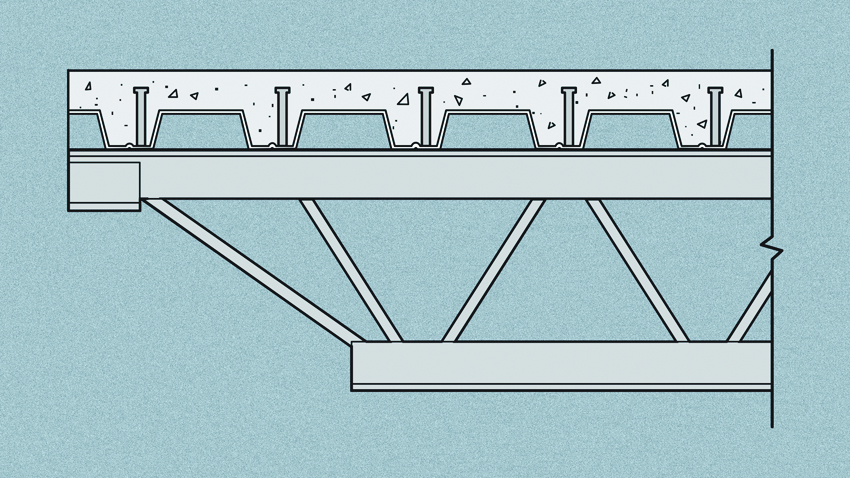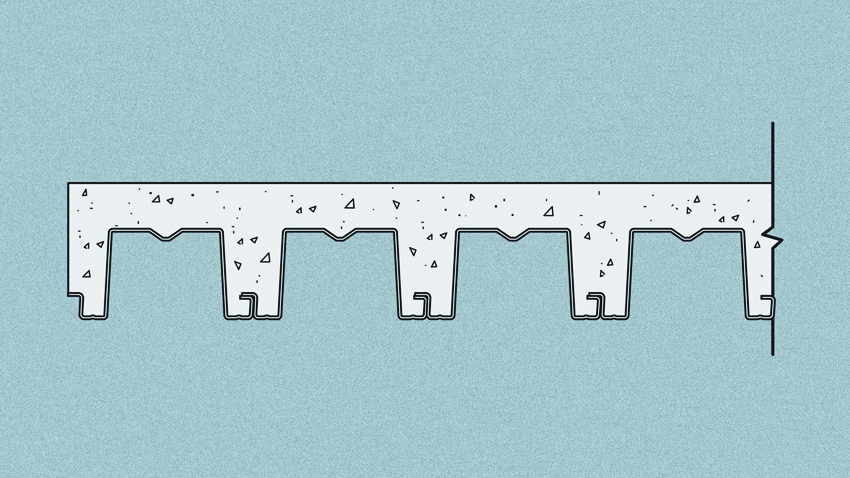Specifying Flooring from the Bottom Up
Finish Flooring
The selection of a finish flooring to be applied over a floor structure is based on a variety of inputs and design criteria. The shape and size of an interior space will be a determinant of things like pattern, scaling, and visual presence of the flooring. The other surfaces in the spaces (such as walls, ceilings, etc.) will influence the choice of materials, colors, and textures used for flooring in the same space, either to extend a particular visual effect or complement the interior design. When considering what to select, there are often multiple choices to pick from in terms of flooring types, but ultimately it comes down to the judgment of the design professional to make the preferred recommendation. In that regard, it is always good to be up to date on relatively new materials that can meet a variety of design conditions and still perform well at a competitive cost.
An example of such a new material is called sintered stone. Sintering is a manufacturing process that uses natural mineral materials in powder form and processes them under heat and pressure to create a product similar to porcelain tile. However, the properties of sintered stone are generally superior to porcelain tile in that it is denser, which makes it stronger, more durable, and generally more resilient. In the case of sintered stone made for flooring products, minerals and other natural materials are ground into a powder and subjected to specific heat and pressure to produce a uniquely broad combination of design characteristics. Sintered stone flooring is resistant to stains, scratches, chemicals, and heat. Additionally, its high density makes it virtually waterproof—it has a porosity less than 0.09 percent, meaning no sealers are required. Those who maintain the building find the dense, nonporous surface easy to clean, including graffiti removal, so the appearance and color are maintained over time. It is even resistant to harsh chemicals.
From a purely design standpoint, sintered stone flooring can provide the look of other familiar materials, such as stone, tile, or wood, with surfaces that are either smooth or textured and available in a variety of colors and hues. Of particular interest to many designers, it is available in larger sizes than conventional porcelain or ceramic tile. Sintered stone product sizes range from 12-inch by 24-inch tiles up to 60-inch by 60-inch tiles, or full slabs that are 4 feet by 12 feet or 5 feet by 10.5 feet. Larger sizes mean minimal grout lines for more elegant visual designs and less concern about keeping those lines clean.
In addition to the variety of size formats, sintered stone is also available in different thicknesses. Because it is so dense, it can be manufactured down to a thin 1⁄8 inch, although 1⁄4-inch and 1⁄2-inch products are more commonly used. Regardless, the thinner, denser products are more lightweight, coming in at only 1.1–1.5 pounds per square foot for a 1⁄8-inch-thick panel. This lighter weight makes it ideal for renovation projects in addition to new construction. The floor slabs can be applied directly onto existing surfaces, eliminating the need for gut remodeling or costly tear-outs while reducing landfill waste.
The appearance and color of sintered stone is wide and varied with more than 50 full-body colorations and digitally enhanced patterns available, allowing design professionals to exercise full creative control over their projects. Depending on the manufacturer, sintered stone can be created to take on a highly accurate appearance of marble, granite, other stone, wood grain, or tile. For sizable projects, some manufacturers can work with designers on custom patterns and colorations to be used not only for flooring but also for walls, work surfaces, and other applications. This total combination of choices means that designers have a full palette of colors and appearances from which to choose.
When used specifically for floor surfaces, sintered stone is suitable for all types of spaces, from large hotel lobbies, to midsize retail or restaurant settings, to small residential or commercial bathrooms, and just about everything in between. The degree of wear resistance needed in any of these spaces can be accommodated by picking the proper thickness of sintered stone to suit the situation. The thickness choices can also help provide smooth transitions with adjacent floor finishes. Grand spaces can have thin sintered stone floors that look like marble, granite, or other dramatic stone. For restaurant and retail spaces, the colors and textures can be selected to complement the rest of the decor, creating spaces that are either bold and strong or soft and intimate depending on the situation. For bathroom and kitchen spaces, surfaces that look like marble or create contrasts of colors, including the creation of tubs and other items, can be designed to meet the intended results.
Once installed and in use, sintered stone flooring can be an ideal design solution for large-format tiling in high-traffic commercial and residential project applications. As a product solution, it overcomes some of the most common issues with traditional large-format tiles, including weight, expense, and installation difficulty.
Performance Considerations
Beyond the design aspects of floor systems and flooring, there are of course performance requirements that need to be met. Meeting different metrics for safety, structural integrity, durability, and other traits will naturally vary based on the flooring products and systems used. Therefore, it is always worthwhile to investigate the specific options available to determine which ones have the performance attributes that most closely match the needs of a particular project. We look at some examples of this process in the following sections.
Composite Floor System Performance
To understand the performance characteristics of long-span composite floors, it is important to remember that they function by using the best of each material as part of a hybrid system: the tensile strength of a corrugated metal deck and the compressive strength of reinforced concrete. Together, this system allows for longer spans that can eliminate the need for intermediate supports and create a single floor/ceiling assembly that allows for more economical and space-efficient floor-to-floor heights.
There are three common types of long-span composite floor structures on the market. These floor structures are optimal for low and mid-rise building designs because they are uniquely space- and cost-efficient. The three types of long-span composite floor systems are 1) composite joist, 2) deep-deck composite, and 3) dovetail composite. Each are described further as follows.
Composite joist floor systems: This system consists of an open-web steel joist that helps to support a corrugated metal deck above that is filled with concrete. Due to the additional truss support, composite joist floor systems offer the longest open-span floor structures, ranging from 20 feet to 60 feet and even beyond. These systems provide a structural floor that uses a lighter, shallower, and lower-cost design compared to concrete beams and wide flange steel beams but can be engineered to provide a very rigid surface with low vibrations.

Image courtesy of New Millennium Building Systems
Composite joist floor systems support the longest unobstructed spans ranging up to 60 feet and beyond.
Due to the joist webbing, mechanical, electrical, and plumbing lines can be run through the open webs of each joist rather than being run under a solid beam or other structural components. This means that the ceiling can stay up closer to the floor structure, optimizing ceiling height in the space below.
Deep-deck composite floor systems: For floor systems that do not need the extra span capability of composite joists, deep-deck composite floor systems can be used, which eliminate the use of the open-web steel joists altogether. Deep-deck composite floors can support unobstructed floor spans in the midrange of many design needs, up to approximately 36 feet. This means that they are well suited for many buildings where open space and free-flowing interiors are sought. Three progressively deeper deck profiles are available, including 4.5 inches, 6 inches, and 7.5 inches, each with its own span capabilities. The specific thickness can be selected to meet engineering criteria relative to the actual project floor span or requirements for controlling floor depth. Other performance objectives such as fireproofing and sound control can also be met by selecting the proper thickness.

Image courtesy of New Millennium Building Systems
Deep-deck composite floor systems can span the midrange of up to 36 feet and can potentially be installed without shoring or support in spans up to 22 feet.
Notice


www.newmill.com









